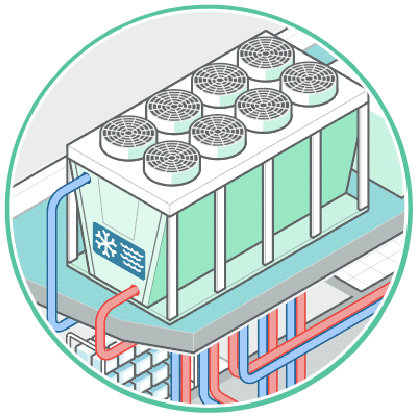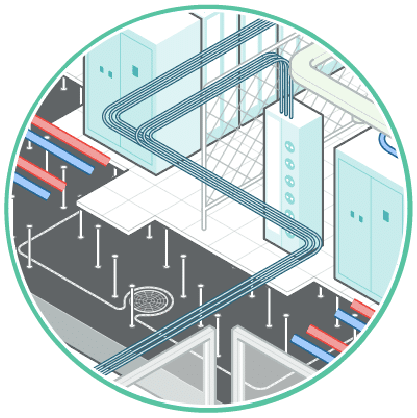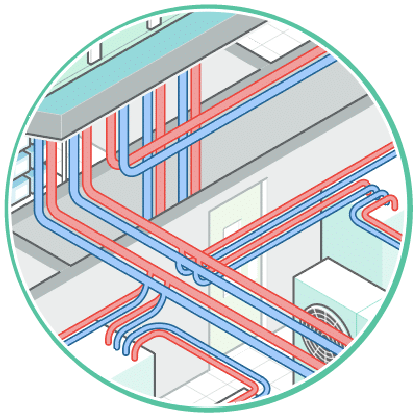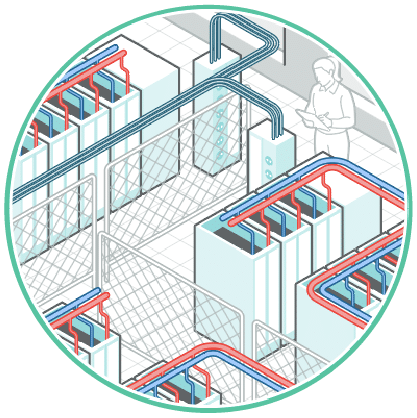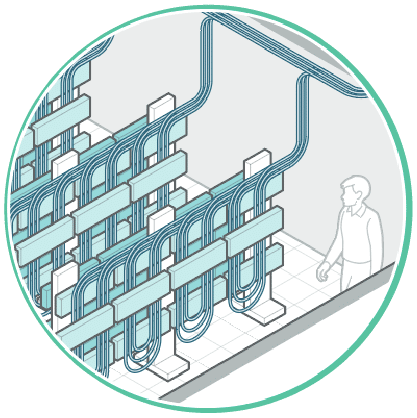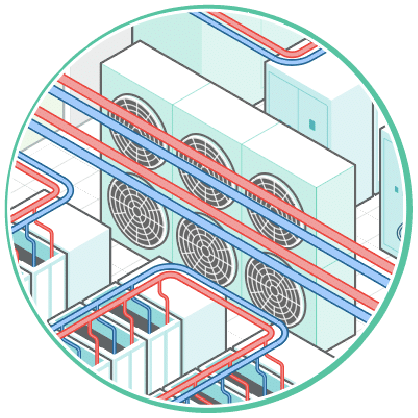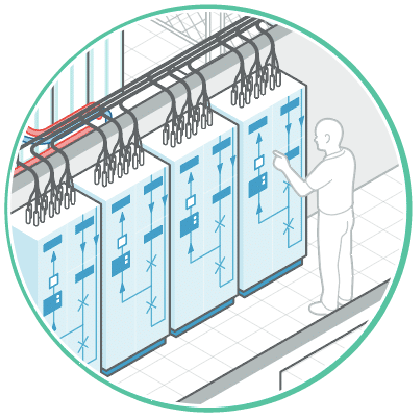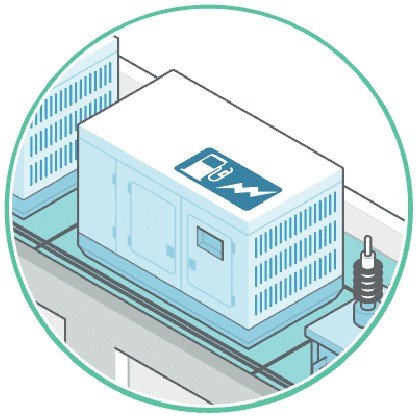Colocation
Data Centers
Businesses rely on colocation data centers to securely house their IT infrastructure, and over the past few years, they’ve become an increasingly crucial staple of modern internet frameworks.
Colocation centers are responsible for providing a low-risk scalable environment for tenant servers and networks. This means delivering continuous uptime and ensuring that one tenant’s failure will not affect others. Colocation data centers need real-time monitoring systems that support the unique demands of distributed architecture.
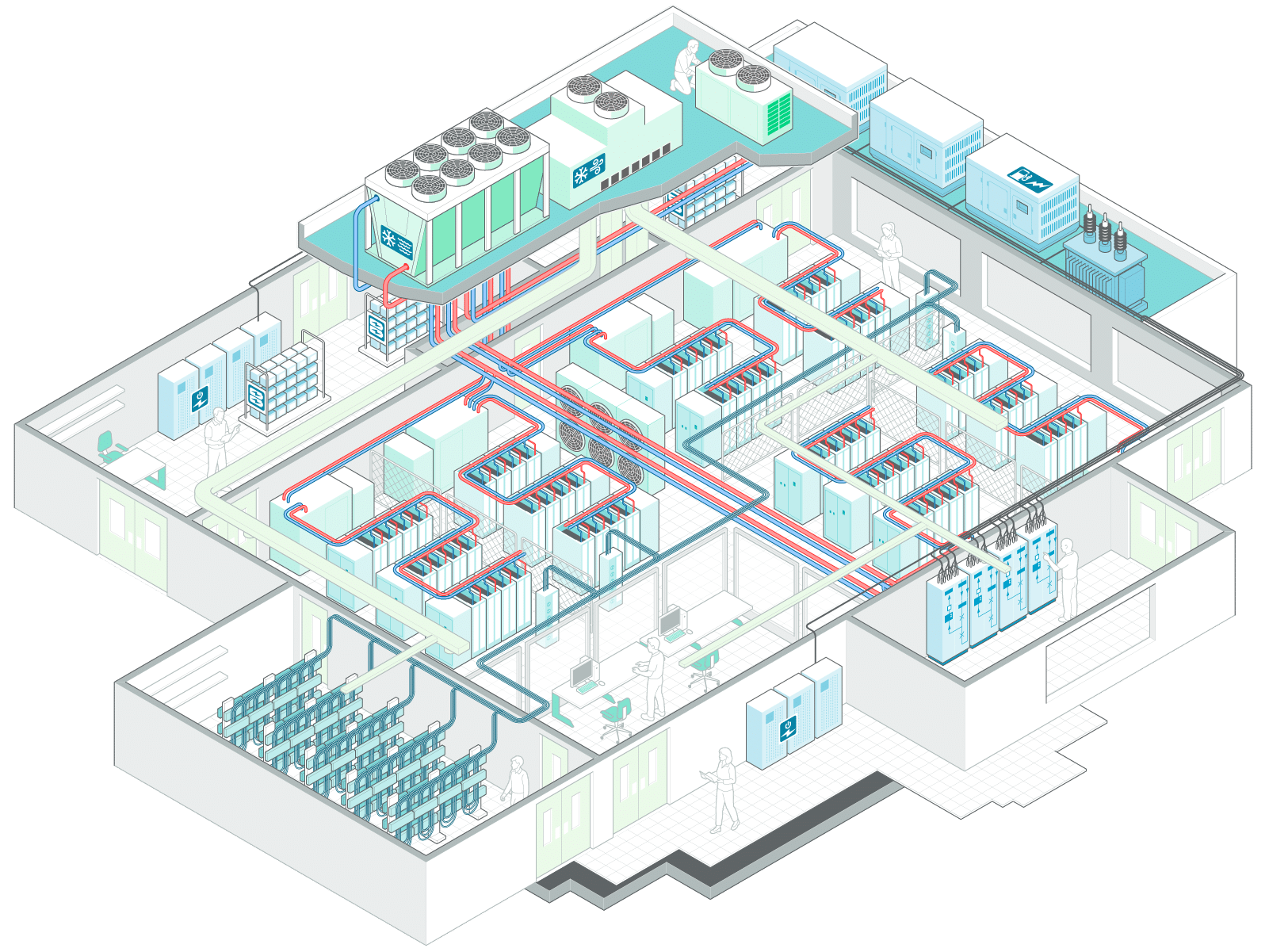
Primary Cooling Units
Rooftop chillers and air handlers are exposed to unexpected conditions. To ensure continuous operation, Parameter installs sensors at strategic fail points to detect leaks and other mechanical issues.
UPS & Battery Banks
UPS systems support the critical power needs of your facility. Parameter provides continuous monitoring on your system’s battery banks to detect failures long before they occur.
Reduce system vulnerability by 90% and prevent all critical battery string failures to ensure uptime reliability.
Raised Flooring
We offer many solutions for facilities with raised flooring, from under-floor leak detection cable and airflow sensors, to our own proprietary raised flooring system. Our raised flooring solutions prioritize ease of service and installation while achieving better turbulent flow and air distribution than our competitors and resulting in 5-15 degrees lower server temperature.
Liquid Cooling
When using liquid cooling in a high-density server application, failure safeguarding is essential. Parameter’s RLE Leak Detection has been leading the industry for decades, and that innovation is why we are the go-to solution for hyperscale liquid cooling leak detection.
Zone Partitioning
It is crucial to keep segmented boundaries between tenant zones while maintaining global facility operation and environment conditions. Parameter’s distributed architecture makes it simple to maintain full visibility with dedicated zone systems.
Meet Me Room
Meet-me room (MMR) is a place within a colocation center where telecommunications companies can physically connect to one another and exchange data. Secure connection and protocol integration is crucial to maintain this communication without leaking data from segmented zones.
Hot / Cold Aisle
Maintaining proper hot and cold aisle temperatures is key to optimizing performance as well as preventing failures.
Parameter’s environmental monitoring solutions provide easily deployable and scalable temp / humidity readings.
Switchgears
Switchgear Batteries are often overlooked as failure points in critical systems. These batteries can remain on standby for long periods of time and only show signs of failure when they are needed during an outage risk event.
Continual monitoring of all critical battery strings is vital to ensure facility uptime.
Generator Batteries
Maintaining healthy generator batteries is crucial to ensure your facility can survive a utility power failure.
UPS systems are critical to protect against the first moments of vulnerability, but most only last for a few minutes. A single cell failure can compromise an entire string of generator starter batteries, leading to prolonged downtime.
Parameter Applications for Colocation Data Centers
Click inside to view how Parameter systems integrate with critical infrastructure to provide the highest quality monitoring solution for colocation data centers.
Monitoring Considerations
Multitenant Risk Mitigation
Colocation data centers serve multiple tenants operating in close proximity to one another, and failures in one area can spread to affect others, causing cross-facility outages. These centers need risk mitigation to contain threats before they spread between distributed architecture.
SLA Compliance & Uptime Documentation
Colocation tenants expect continuous uptime. Uptime Service Level Agreements (SLAs) require data centers to provide a minimum percentage of uptime and prove compliance through documentation. Unmitigated threats can compromise SLA compliance, but effective monitoring enhances SLA compliance by indicating failures and facilitating data collection for documentation.
Streamlined Integration & Installation
The data center world moves at a rapid pace, and to accommodate tenants’ changing needs, colocation facilities may undergo frequent renovations. Monitoring equipment should not be a limiting factor, so all systems have to be flexible and easy to install for seamless integration throughout renovations.
Real-Time Alerts
The best way to prevent threats from spreading is to catch them immediately. A vigilant monitoring system delivers real-time alerts the instant threats are detected so they can be located and neutralized before spreading.
Failure Points
UPS Systems
Battery-based Uninterruptible Power Supply (UPS) systems support critical functions when primary power sources aren’t available. Because these systems play a vital role in sustaining uptime and protecting data integrity, tenants expect them to be vigilantly maintained and ready to deploy at all times.
Distributed Architecture & Data Collection
Colocation data centers are typically designed with distributed architecture, which aims to keep tenants’ infrastructures separate so that failures in one area don’t affect others. For this approach to work, facilities need threat detection that enables centralized monitoring and data collection across disparate infrastructure so that no matter where a threat occurs, it can be located and addressed immediately.
Controlled Environments
Factors like temperature, humidity, CO2, and airflow can impact server performance across tenant infrastructure. To optimize efficiency, prevent downtime, and safeguard equipment, collocation data centers must maintain carefully controlled environments.
Cooling Systems
The high-density equipment housed in colocation data centers requires exceptionally efficient cooling methods to prevent overheating. Whether utilizing liquid cooling or CRAC/CRAH units, refrigerant and cooling fluid are susceptible to leaks that can be harmful to nearby servers and equipment.

Leak Detection
Leaks are one of the leading causes of downtime in data centers. Because they often start small and escalate quickly to cause facility-wide damage, they are especially troublesome in colocation data centers that serve multiple tenants, where a single leak can lead to mass outages across the board. Although they play a necessary role in regulating temperature, cooling systems are responsible for the majority of these leaks.
Leak detection is the first line of defense for protecting cross-tenant infrastructure. Parameter’s RLE Leak Detection technology can pinpoint the precise location of a leak as soon as it occurs, ensuring distributed teams have time to contain it before it spreads.
Powered by RLE leak detection, our proprietary server-level direct-to-chip liquid cooling leak detection system is already being implemented in critical data center operations. This technology can pinpoint the precise location of a leak as soon as it occurs, ensuring technicians have enough time to contain it before it spreads. Parameter solutions can also be used to detect water and conductive leaks caused by CRAC/CRAH infrastructure.
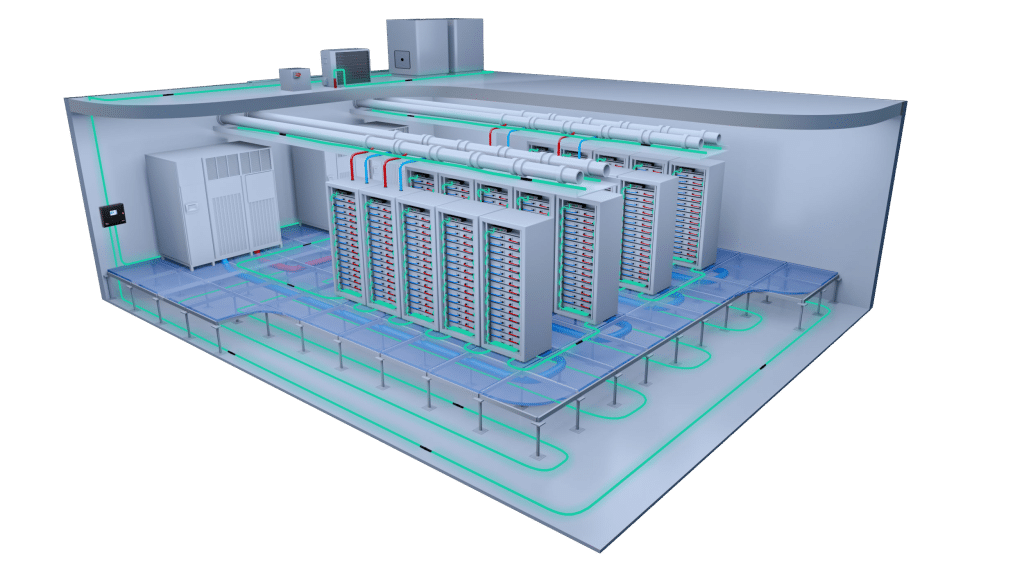
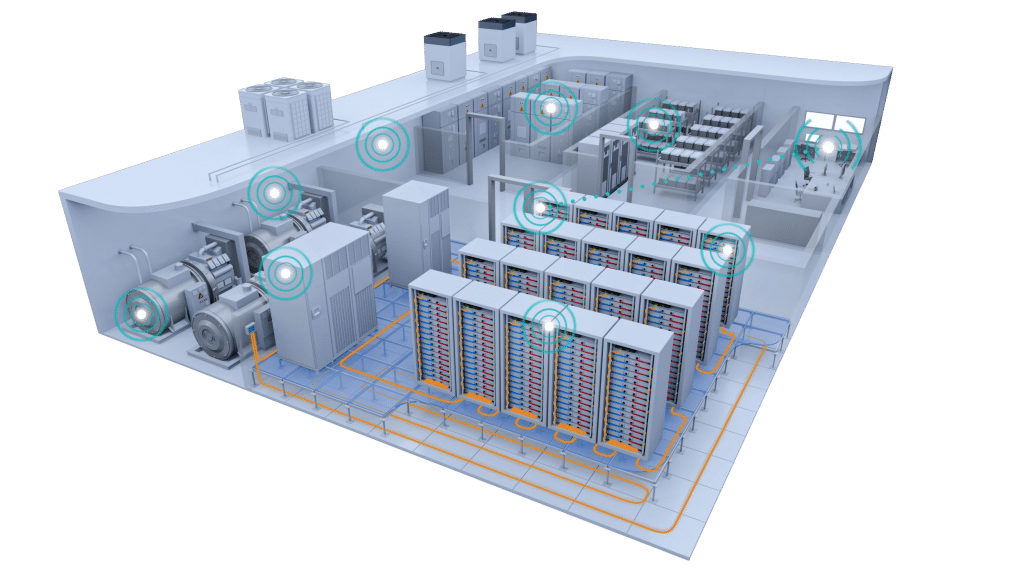
Environmental Monitoring
Maintaining an optimal environment and keeping temperatures low is essential for delivering continuous uptime and protecting tenant operations.
When atmospheric conditions fall outside of expected parameters, colocation tenants can face far-reaching consequences such as equipment damage, efficiency losses, and downtime.
Like leaks, these failures can spread across tenants, and because atmospheric changes can happen suddenly, colocation centers need effective monitoring systems to ensure uptime SLA compliance.
Parameter empowers colocation data centers with visibility into critical aspects of environmental infrastructure. RLE Environmental Monitoring technology tracks multiple conditions, including temperature, humidity, airflow, CO2, and more. When a failure is detected, the system immediately sends out an alert indicating the nature and location of the issue.
Battery Monitoring
Tenants need confidence that the data center they rely on will provide constant uptime, and UPS battery integrity is a big part of that.
Battery-powered UPS systems allow colocation centers to maintain uptime during grid outages, but they are also prone to failures. It only takes a single failed cell to compromise an entire string, and failures can occur unexpectedly.
Without a way to monitor battery health in real time and collect data for reports, tenants can’t trust that data centers will be able to deliver on their uptime SLA commitments.
Colocation data centers can ensure UPS integrity and deliver peace of mind for their tenants by implementing a continuous battery monitoring system that is semi-permanently connected to provide live insights into battery health. Through Cellwatch, Parameter technology measures multiple conditions, alerts to failures, and delivers live data on critical units.
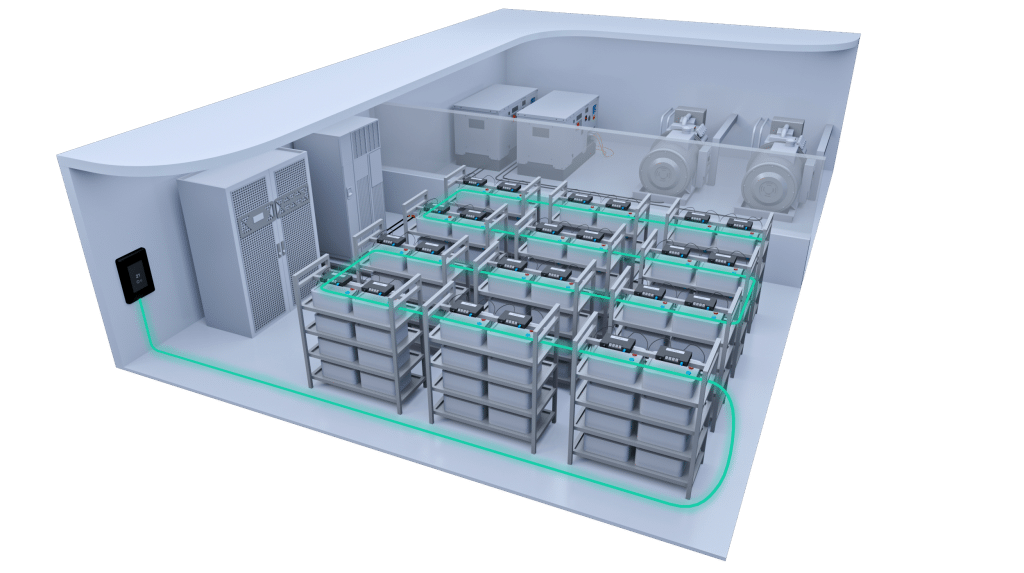
Product Lines


To support the intensive needs of colocation centers, Parameter RLE Leak Detection prioritizes accuracy and responsiveness, transmitting an alarm the instant fluid is detected. With solutions for both water and chemical leaks, Parameter platforms accommodate the leaks risks of in-server liquid cooling methods as well as those of HVAC infrastructure.
Liquid Sensing Cables
Forming the backbone of leak threat mitigation for distributed architecture, Parameter’s conductive fluid sensing cables can be run around the perimeter of a room or in a serpentine pattern under the floor for comprehensive coverage of server rooms. For refrigerant leaks, chemical sensing cables offer especially fast reaction times and are exceptionally durable and resistant to corrosion.
Distance-Read Controllers
Parameter’s bespoke solution for distributed liquid cooling applications is the LD1500 distance-read controller, which monitors up to 1500 feet of cable. When mounted to each server rack and connected to flow valves, LD1500 controllers prevent cross-tenant damage by immediately halting coolant valves, notifying personnel, and identifying the location of the incident as soon as a leak is detected. For large fleets of up to 128 LD1500s, the feature-rich LD5200 can aggregate alerts into a unified interface.
Spot Detectors & Zone Controllers
For more basic applications and readily visible areas, such as HVAC drip pans, floor drains, and condensation outlets, Parameter’s simple and cost-effective spot detectors and zone controllers notify personnel as soon as a leak is detected in a specific area.


With built-in remote monitoring capabilities, Parameter’s RLE Environmental Monitoring platform is designed to help colocation facilities validate SLAs and prevent server failures by tracking critical factors. Wired, wireless, and Wi-Fi equipment options ensure streamlined automation and integration across tenants. There are no recurring fees, and once you’ve purchased the equipment, it’s yours for life.
WiNG Monitoring
Parameter’s hyper-convenient and reliable WiNG wireless platform is as simple to install as placing a magnet on a doorframe. The platform features sensors for dozens of environmental conditions and automatically relays continuous data to the WiNG Manager, allowing hyperscalers to meet efficiency goals, support continuous uptime, and optimize operations. There are no recurring fees, and once you’ve purchased the equipment, it’s yours for life.
Wi-Fi Sensors
For operations that require the utmost security, Parameter simplifies closed-circuit monitoring through the wired Facility Monitoring System (FMS), which monitors sensitive facilities, temperature, and equipment status. To expand FMS functionality, Parameter offers wired sensors for temperature, humidity, motion, door status, smoke, power failures, and power currents.
Wired Facility Monitoring & Sensors
For operations that require the utmost security, Parameter simplifies closed-circuit monitoring through the wired Facility Monitoring System (FMS), which monitors sensitive facilities, temperature, and equipment status. To expand FMS functionality, Parameter offers wired sensors for temperature, humidity, motion, door status, smoke, power failures, and power currents.


Cellwatch Battery Monitoring is semi-permanently connected to deliver real-time monitoring that tracks performance proactively without requiring manual checks, allowing personnel to repair or replace UPS battery units before they need to be deployed.
Real-Time UPS Visibility
Cellwatch Battery Monitoring is semi-permanently connected to deliver real-time monitoring that tracks performance proactively without requiring manual checks, allowing personnel to repair or replace UPS battery units before they need to be deployed.
SLA Validation
To validate SLAs and limit downtime, Cellwatch Battery Monitoring confirms fleet health and collects data for enhanced documentation. By monitoring UPS units constantly, it provides a meaningful layer of reassurance to tenants with concerns about reliability.
Cellwatch Central
In addition to the core Cellwatch product, Parameter also offers Cellwatch Central, a specially tailored platform for multisite monitoring. By consolidating data collection into a unified system, Cellwatch Central enables colocation to analyze battery performance across over 50,000 jars and streamline management of battery types, installation data, and maintenance events via a unified system.
Discover Advanced Data Center Monitoring Solutions From Parameter.
Colocation tenants expect peace of mind at every level of their operations. That’s why Parameter provides tailored solutions for threat detection in distributed architecture.
Contact Parameter to discover advanced platforms for real-time data center monitoring that enable incident prevention and maximize uptime for all tenants.
For custom capabilities and manufacturing, reach out to our OEM team directly to discuss how we can augment your application.

